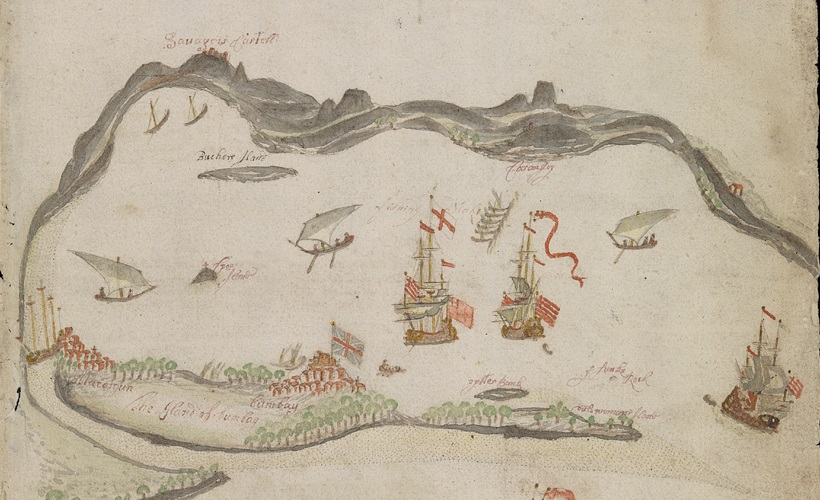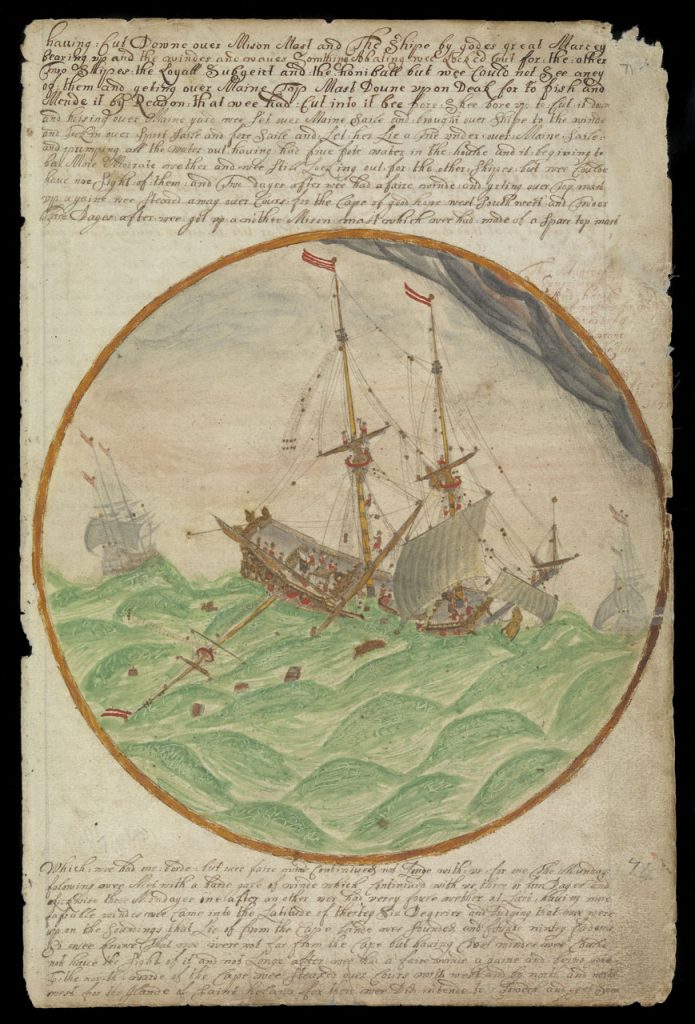We tend to picture 17th century sailors as rowdy, hard-drinking, ‘salty sea dogs’ akin to Captain Redbeard Rum from Blackadder. But sailors’ autobiographies from the time tell a different story, says naval historian Dr Richard Blakemore in this post for #ExploreYourArchives week.

Recently I’ve been working on two sailors’ manuscript autobiographies: one by Edward Barlow, held at the National Maritime Museum, and one by Edward Coxere, held at the Library of Congress. They offer a fascinating glimpse of life at sea in the later seventeenth century – and both Edwards had colourful careers.
Barlow was part of the expedition that brought Charles II to England in 1660 for his restoration, and later sailed to the Mediterranean, the Caribbean, and several times to India and China in service of the East India Company. Coxere served in English, Dutch, and Spanish ships, both merchant ships and ships of war, and he was imprisoned for a while at Tunis.
As the only two full autobiographies by sailors from this period, they are extremely valuable as historical sources. They are particularly useful for correcting the stereotype, prevalent at that time and ever since, of sailors as rowdy, unruly, hard-drinking men, isolated from life ashore. Both Barlow and Coxere mention sailors’ drinking habits, but they are quick (perhaps too quick?) to claim that they themselves did not share such habits.
More importantly, these manuscripts reveal the many important relationships that framed sailors’ lives: family, friends, and professional contacts. Indeed, it sometimes seems that wherever Coxere travelled he ran into someone that he knew. These men were hardly isolated from the rest of society – quite the opposite.
A hidden crime
Several hundred years later, these manuscripts are still yielding up secrets. While working on Barlow’s journal in preparation for the new Tudor and Stuart Seafarers gallery, on which I was a consultant, senior conservator Paul Cook of the National Maritime Museum discovered a page which Barlow had written and then later pasted over, where he admitted that he raped his wife before their marriage.
This episode reveals the darker side to sailors’ relationships, and highlights the difficulty of recovering different perspectives. Little evidence survives about either Barlow’s or Coxere’s wives (both, incidentally, named Mary) beyond their husbands’ writings, and so we cannot know how these women perceived their relationships.

Unsolved mysteries
Yet not all these sources’ secrets have been revealed: from an archival point of view, there are still mysteries. Why did these two men write them in the first place? Sailors often kept navigational journals, but more personal writings by them rarely survive. Both autobiographies were ‘discovered’, and transcriptions of them were published, in the 1930s and 1940s, but their journey from the early eighteenth century to the early twentieth century remains obscure.
Barlow’s lavishly decorated journal is clearly a fair copy, perhaps intended for circulation to a small audience (which makes his candour, on his marriage and other topics, all the more surprising), and may have been kept by his family or a friend.
Coxere’s text is also illustrated, but more simply, and the manuscript which survives is probably a copy of an earlier original. Much of the later part of Coxere’s autobiography describes how he became a Quaker and was persecuted by the state for his beliefs, so his writing may well fit into the tradition of religious conversion narratives, and perhaps it was preserved by a Quaker community.
Sea change
We may never know how these two journals have come down to us through the centuries, but I am very grateful that they have. Among all the evidence they give us, another theme which emerges strongly from these two journals is the impact of the maritime world on early modern Britain – even inland. While Coxere was a mariner’s son, Barlow came originally from Prestwich, near Manchester, where his father was a husbandman.
Maritime Reading?
Reading might not seem the most maritime town, but even Berkshire has its seafaring connections. In the Berkshire Record Office there is the will of William Horner of New Windsor, who died in 1674, and who had served as a ship’s trumpeter: another curious #maritimearchive. Perhaps, during one of their voyages, Barlow or Coxere heard him play. It’s a fanciful thought, but not an impossible one!
Dr Richard Blakemore’s research focuses on the social history of seafarers during the early modern period, their connections with society ashore, and their role in the development of imperial and commercial networks. As an expert on the lives of sailors during the seventeenth and eighteenth centuries, Richard was recently consulted for the launch of a new Tudor and Stuart Seafarers’ gallery, part of a suite of new galleries launched in September at the National Maritime Museum, Greenwich. He also wrote a chapter on ‘life at sea’ for the accompanying book.
You can watch Richard talking about pirates in this short University of Reading video he made for Talk Like A Pirate Day 2018:
